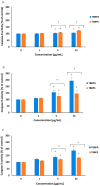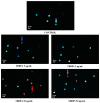Determination of Apoptotic Mechanism of Action of Tetrabromobisphenol A and Tetrabromobisphenol S in Human Peripheral Blood Mononuclear Cells: A Comparative Study
- PMID: 36144785
- PMCID: PMC9500834
- DOI: 10.3390/molecules27186052
Determination of Apoptotic Mechanism of Action of Tetrabromobisphenol A and Tetrabromobisphenol S in Human Peripheral Blood Mononuclear Cells: A Comparative Study
Abstract
Background: Tetrabromobisphenol A (TBBPA) is the most commonly used brominated flame retardant (BFR) in the industry. TBBPA has been determined in environmental samples, food, tap water, dust as well as outdoor and indoor air and in the human body. Studies have also shown the toxic potential of this substance. In search of a better and less toxic BFR, tetrabromobisphenol S (TBBPS) has been developed in order to replace TBBPA in the industry. There is a lack of data on the toxic effects of TBBPS, while no study has explored apoptotic mechanism of action of TBBPA and TBBPS in human leukocytes.
Methods: The cells were separated from leucocyte-platelet buffy coat and were incubated with studied compounds in concentrations ranging from 0.01 to 50 µg/mL for 24 h. In order to explore the apoptotic mechanism of action of tested BFRs, phosphatidylserine externalization at cellular membrane (the number of apoptotic cells), cytosolic calcium ion and transmembrane mitochondrial potential levels, caspase-8, -9 and -3 activation, as well as PARP-1 cleavage, DNA fragmentation and chromatin condensation in PBMCs were determined.
Results: TBBPA and TBBPS triggered apoptosis in human PBMCs as they changed all tested parameters in the incubated cells. It was also observed that the mitochondrial pathway was mainly involved in the apoptotic action of studied compounds.
Conclusions: It was found that TBBPS, and more strongly TBBPA, triggered apoptosis in human PBMCs. Generally, the mitochondrial pathway was involved in the apoptotic action of tested compounds; nevertheless, TBBPS more strongly than TBBPA caused intrinsic pathway activation.
Keywords: PARP-1 cleavage; apoptosis; caspase activation; chromatin condensation; cytosolic calcium ion level; peripheral blood mononuclear cells; tetrabromobisphenol A; tetrabromobisphenol S; transmembrane mitochondrial potential.
Conflict of interest statement
The authors declare no conflict of interest.
Figures









Similar articles
-
Genotoxic Mechanism of Action of TBBPA, TBBPS and Selected Bromophenols in Human Peripheral Blood Mononuclear Cells.Front Immunol. 2022 Apr 12;13:869741. doi: 10.3389/fimmu.2022.869741. eCollection 2022. Front Immunol. 2022. PMID: 35493487 Free PMC article.
-
Apoptosis-Inducing Potential of Selected Bromophenolic Flame Retardants 2,4,6-Tribromophenol and Pentabromophenol in Human Peripheral Blood Mononuclear Cells.Molecules. 2022 Aug 9;27(16):5056. doi: 10.3390/molecules27165056. Molecules. 2022. PMID: 36014294 Free PMC article.
-
Tetrabromobisphenol A, terabromobisphenol S and other bromophenolic flame retardants cause cytotoxic effects and induce oxidative stress in human peripheral blood mononuclear cells (in vitro study).Chemosphere. 2020 Dec;261:127705. doi: 10.1016/j.chemosphere.2020.127705. Epub 2020 Jul 19. Chemosphere. 2020. PMID: 32731020
-
Distribution, transformation, and toxic effects of the flame retardant tetrabromobisphenol S and its derivatives in the environment: A review.Sci Total Environ. 2024 Oct 20;948:174799. doi: 10.1016/j.scitotenv.2024.174799. Epub 2024 Jul 15. Sci Total Environ. 2024. PMID: 39019271 Review.
-
Review of the environmental occurrence, analytical techniques, degradation and toxicity of TBBPA and its derivatives.Environ Res. 2022 Apr 15;206:112594. doi: 10.1016/j.envres.2021.112594. Epub 2021 Dec 29. Environ Res. 2022. PMID: 34973196 Review.
Cited by
-
Guardians under Siege: Exploring Pollution's Effects on Human Immunity.Int J Mol Sci. 2024 Jul 16;25(14):7788. doi: 10.3390/ijms25147788. Int J Mol Sci. 2024. PMID: 39063030 Free PMC article. Review.
-
Update of the scientific opinion on tetrabromobisphenol A (TBBPA) and its derivatives in food.EFSA J. 2024 Jul 15;22(7):e8859. doi: 10.2903/j.efsa.2024.8859. eCollection 2024 Jul. EFSA J. 2024. PMID: 39010865 Free PMC article.
-
Update of the risk assessment of brominated phenols and their derivatives in food.EFSA J. 2024 Oct 23;22(10):e9034. doi: 10.2903/j.efsa.2024.9034. eCollection 2024 Oct. EFSA J. 2024. PMID: 39444985 Free PMC article.
References
-
- Yang H., Luo X.-J., Zeng Y.-H., Mai B.-X. Determination of tetrabromobisphenol-A/S and their eight derivatives in abiotic (soil/dust) samples using ultra-high performance liquid chromatography-tandem mass spectrometry. J. Chromat. A. 2021;1647:462152. doi: 10.1016/j.chroma.2021.462152. - DOI - PubMed
-
- Macêdo W., Sánchez F., Zaiat M. What drives tetrabromobisphenol A degradation in biotreatment systems? Rev. Environ. Sci. Bio/Technol. 2021;20:729–750. doi: 10.1007/s11157-021-09579-9. - DOI
MeSH terms
Substances
Grants and funding
LinkOut - more resources
Full Text Sources
Miscellaneous

